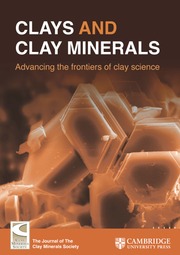Crossref Citations
This article has been cited by the following publications. This list is generated based on data provided by
Crossref.
Uysal, I.Tonguç
Golding, Suzanne D
and
Baublys, Kim
2000.
Stable isotope geochemistry of authigenic clay minerals from Late Permian coal measures, Queensland, Australia: implications for the evolution of the Bowen Basin.
Earth and Planetary Science Letters,
Vol. 180,
Issue. 1-2,
p.
149.
Uysal, I.Tonguc
Glikson, Miryam
Golding, Suzanne D
and
Audsley, Frank
2000.
The thermal history of the Bowen Basin, Queensland, Australia: vitrinite reflectance and clay mineralogy of Late Permian coal measures.
Tectonophysics,
Vol. 323,
Issue. 1-2,
p.
105.
Uysal, I.T.
Golding, S.D.
and
Glikson, M.
2000.
Petrographic and isotope constraints on the origin of authigenic carbonate minerals and the associated fluid evolution in Late Permian coal measures, Bowen Basin (Queensland), Australia.
Sedimentary Geology,
Vol. 136,
Issue. 3-4,
p.
189.
Uysal, I.Tonguç
Golding, Suzanne D.
and
Thiede, David S.
2001.
K–Ar and Rb–Sr dating of authigenic illite–smectite in Late Permian coal measures, Queensland, Australia: implication for thermal history.
Chemical Geology,
Vol. 171,
Issue. 3-4,
p.
195.
Hower, James C
and
Gayer, Rodney A
2002.
Mechanisms of coal metamorphism: case studies from Paleozoic coalfields.
International Journal of Coal Geology,
Vol. 50,
Issue. 1-4,
p.
215.
Uysal, I.Tonguç
and
Golding, Suzanne D
2003.
Rare earth element fractionation in authigenic illite–smectite from Late Permian clastic rocks, Bowen Basin, Australia: implications for physico-chemical environments of fluids during illitization.
Chemical Geology,
Vol. 193,
Issue. 3-4,
p.
167.
Uysal, I. T.
Glikson, M.
Golding, S. D.
and
Southgate, P. N.
2004.
Hydrothermal control on organic matter alteration and illite precipitation, Mt Isa Basin, Australia.
Geofluids,
Vol. 4,
Issue. 2,
p.
131.
Arostegui, J.
Sangüesa, F. J.
Nieto, F.
and
Uriarte, J. A.
2006.
Thermal models and clay diagenesis in the Tertiary-Cretaceous sediments of the Alava block (Basque-Cantabrian basin, Spain).
Clay Minerals,
Vol. 41,
Issue. 4,
p.
791.
Tonguç Uysal, I.
Zhao, Jian-Xin
Golding, Suzanne D.
Lawrence, Michael G.
Glikson, Miryam
and
Collerson, Kenneth D.
2007.
Sm–Nd dating and rare-earth element tracing of calcite: Implications for fluid-flow events in the Bowen Basin, Australia.
Chemical Geology,
Vol. 238,
Issue. 1-2,
p.
63.
Shrivastava, Jaya Prakash
and
Ahmad, Mansoor
2008.
Trace element compositions of iridium enriched illite-smectite assemblages from a K/Pg boundary section in the Anjar area of the Deccan volcanic province: palaeoenvironmental implications.
Cretaceous Research,
Vol. 29,
Issue. 4,
p.
592.
BERTIER, PIETER
SWENNEN, RUDY
LAGROU, DAVID
LAENEN, BEN
and
KEMPS, RAYMOND
2008.
Palaeo‐climate controlled diagenesis of the Westphalian C & D fluvial sandstones in the Campine Basin (north‐east Belgium).
Sedimentology,
Vol. 55,
Issue. 5,
p.
1375.
Uysal, I. Tonguç
Golding, Suzanne D.
Bolhar, Robert
Zhao, Jian-xin
Feng, Yue-xing
Baublys, Kim A.
and
Greig, Alan
2011.
CO2 degassing and trapping during hydrothermal cycles related to Gondwana rifting in eastern Australia.
Geochimica et Cosmochimica Acta,
Vol. 75,
Issue. 19,
p.
5444.
Golding, S.D.
Uysal, I.T.
Boreham, C.J.
Kirste, D.
Baublys, K.A.
and
Esterle, J.S.
2011.
Adsorption and mineral trapping dominate CO2 storage in coal systems.
Energy Procedia,
Vol. 4,
Issue. ,
p.
3131.
Permana, Asep K.
Ward, Colin R.
Li, Zhongsheng
and
Gurba, Lila W.
2013.
Distribution and origin of minerals in high-rank coals of the South Walker Creek area, Bowen Basin, Australia.
International Journal of Coal Geology,
Vol. 116-117,
Issue. ,
p.
185.
Golding, S. D.
Uysal, I. T.
Bolhar, R.
Boreham, C. J.
Dawson, G. K. W.
Baublys, K. A.
and
Esterle, J. S.
2013.
Carbon dioxide-rich coals of the Oaky Creek area, central Bowen Basin: a natural analogue for carbon sequestration in coal systems.
Australian Journal of Earth Sciences,
Vol. 60,
Issue. 1,
p.
125.
Owen, Daniel D.R.
Raiber, Matthias
and
Cox, Malcolm E.
2015.
Relationships between major ions in coal seam gas groundwaters: Examples from the Surat and Clarence-Moreton basins.
International Journal of Coal Geology,
Vol. 137,
Issue. ,
p.
77.
Middleton, Alexander W.
Uysal, I. Tonguç
and
Golding, Suzanne D.
2015.
Chemical and mineralogical characterisation of illite–smectite: Implications for episodic tectonism and associated fluid flow, central Australia.
Geochimica et Cosmochimica Acta,
Vol. 148,
Issue. ,
p.
284.
Liu, Entao
Song, Yinxian
Wang, Hua
Liu, Haibo
Ayoko, Godwin A.
Frost, Ray L.
and
Xi, Yunfei
2016.
Vibrational spectroscopic characterization of mudstones in a hydrocarbon-bearing depression, South China Sea: Implications for thermal maturity evaluation.
Spectrochimica Acta Part A: Molecular and Biomolecular Spectroscopy,
Vol. 153,
Issue. ,
p.
241.
Sánchez-Roa, Catalina
Jiménez-Millán, Juan
Abad, Isabel
Faulkner, Daniel R.
Nieto, Fernando
and
García-Tortosa, Francisco J.
2016.
Fibrous clay mineral authigenesis induced by fluid-rock interaction in the Galera fault zone (Betic Cordillera, SE Spain) and its influence on fault gouge frictional properties.
Applied Clay Science,
Vol. 134,
Issue. ,
p.
275.
Erkoyun, Hülya
Kadir, Selahattin
Külah, Tacit
and
Huggett, Jennifer
2017.
Mineralogy, geochemistry and genesis of clays interlayered coal seams succession in the Neogene lacustrine Seyitömer coal deposit, Kütahya, western Turkey.
International Journal of Coal Geology,
Vol. 172,
Issue. ,
p.
112.

